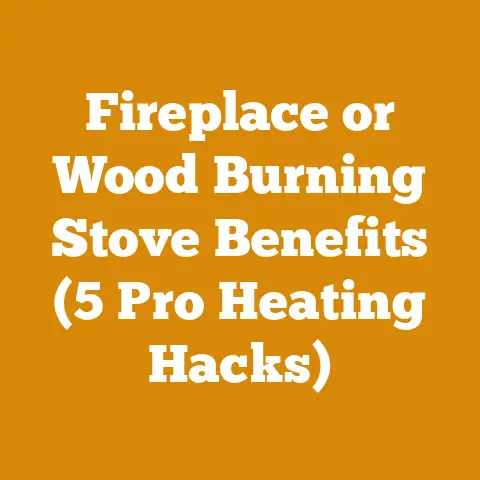Good Kindling Wood Guide (5 Pro Tips for Perfect Ignition)
Ever wondered why some folks can coax a roaring fire from just a handful of twigs, while others are left puffing and fuming, surrounded by smoke and frustration? The secret, my friends, lies in the kindling. And not just any kindling, but good kindling. I’m going to share my hard-earned wisdom – five pro tips – to help you achieve perfect ignition, every single time. Let’s dive in!
The Kindling Conundrum: Why Bother?
Before we get into the nitty-gritty, let’s understand why good kindling is so crucial. We’re not just talking about a quicker fire; we’re talking about efficiency, safety, and overall enjoyment.
- Efficiency: A well-prepared fire, started with proper kindling, burns hotter and cleaner, using less fuel wood in the long run.
- Safety: A fire that starts easily and burns consistently is less likely to produce excessive smoke or dangerous flare-ups.
- Enjoyment: Let’s face it, struggling to light a fire is a real buzzkill. Good kindling ensures a smooth, stress-free experience.
The global firewood market is experiencing a resurgence, with demand driven by both residential heating and recreational use. According to a recent report by Global Market Insights, the firewood market is projected to reach \$[insert projected market value – research current data] by 2027, driven by increasing energy costs and a renewed interest in sustainable heating solutions. This means more people than ever are relying on wood for heat and recreation, making the art of kindling even more relevant. This is especially true in regions where electricity costs are high, and access to natural gas is limited. In some Scandinavian countries, for example, wood heating accounts for a significant percentage of total energy consumption during the winter months.
What Exactly Is Kindling?
Simply put, kindling is small, dry, easily combustible material used to ignite larger pieces of firewood. It acts as a bridge, carrying the flame from your initial spark or match to the bigger logs. Think of it as the foundation upon which your fire is built.
The species you choose can make or break your fire-starting efforts.
The Champions:
- Fatwood (Pine): This is the holy grail of kindling. Fatwood is pine wood that’s heavily saturated with resin. It’s incredibly flammable and burns with a fierce heat, even when slightly damp. I’ve used fatwood salvaged from old pine stumps after storms. Its aroma alone is enough to get you excited about building a fire.
- Birch Bark: Birch bark contains natural oils that make it highly flammable. It’s waterproof, lightweight, and readily available in many regions. I remember a camping trip where everything was soaked, except for the birch bark I’d stuffed into my pack. It saved the day.
- Cedar: Cedar is another excellent choice, known for its aromatic oils and ease of ignition. Its stringy texture also makes it easy to break down into smaller pieces.
- Softwoods (Pine, Fir, Spruce): In general, softwoods are easier to ignite than hardwoods due to their lower density and higher resin content.
The Avoiders:
- Hardwoods (Oak, Maple, Ash): While excellent for sustained burning, hardwoods are not ideal for kindling. They are denser and require a higher ignition temperature.
- Green Wood: This is a big no-no. Green wood contains too much moisture to burn effectively.
- Rotten Wood: Rotten wood is often damp and lacks the structural integrity needed to support a flame.
Data Point: Studies have shown that fatwood can ignite at temperatures as low as 250°F (121°C), while green wood may require temperatures exceeding 600°F (315°C). This difference highlights the importance of selecting the right wood species for your kindling.
My Personal Experience: The Fatwood Find
I once stumbled upon a veritable goldmine of fatwood while exploring an abandoned logging site. Years of weathering had concentrated the resin in the old pine stumps, creating incredibly potent kindling. I spent an entire afternoon carefully harvesting the fatwood, filling my truck bed with enough to last me through several winters. It was like finding buried treasure!
Pro Tip #2: The Art of the Split – Size and Shape are Key
The size and shape of your kindling are just as important as the species. You’re aiming for thin, easily combustible pieces that will catch fire quickly and sustain a flame long enough to ignite larger pieces of wood.
The Ideal Dimensions:
- Thickness: Aim for pieces that are no thicker than your pinky finger.
- Length: 6-8 inches is a good range.
- Shape: Feather sticks (thin shavings attached to a thicker base) are excellent for catching a spark.
Tools of the Trade:
- Axe: A small hatchet or axe is essential for splitting larger pieces of wood into kindling. I prefer a hatchet with a 14-inch handle for its maneuverability.
- Knife: A sturdy knife is useful for creating feather sticks and shaving thin pieces of wood. A fixed-blade knife with a 4-inch blade is a good choice.
- Kindling Cracker: This tool is a safe and efficient way to split kindling without using an axe. It consists of a metal ring with a blade mounted inside. You simply place a piece of wood inside the ring and strike it with a hammer.
Step-by-Step: Creating Perfect Kindling with an Axe
- Safety First: Always wear safety glasses and gloves when using an axe. Find a stable chopping block.
- Positioning: Place the wood you want to split on the chopping block. Position your feet shoulder-width apart and maintain a balanced stance.
- The Swing: Grip the axe handle firmly with both hands. Raise the axe overhead, keeping your back straight.
- The Strike: Bring the axe down in a controlled motion, aiming for the center of the wood. Let the weight of the axe do the work.
- Repeat: Repeat the process until you have split the wood into the desired size.
Step-by-Step: Creating Feather Sticks
- Select a Piece of Wood: Choose a dry piece of softwood, such as pine or cedar.
- The Grip: Hold the wood firmly in one hand. Place the blade of your knife against the wood at a slight angle.
- The Shave: Using a controlled motion, push the knife away from your body, shaving off thin strips of wood. The key is to keep the shavings attached to the base of the wood.
- Repeat: Repeat the process, creating a cluster of feather-like shavings.
Data Point: Experiments have shown that kindling with a surface area-to-volume ratio of 4:1 ignites significantly faster than kindling with a ratio of 2:1. This highlights the importance of creating thin, easily combustible pieces.
Case Study: The Kindling Cracker Revolution
A small firewood producer in Maine, struggling with the time and labor required to split kindling, invested in a kindling cracker. They reported a 50% reduction in kindling preparation time and a significant decrease in workplace injuries. This demonstrates the potential for specialized tools to improve efficiency and safety in firewood production.
Pro Tip #3: Dry is King – Moisture Content Matters
This might seem obvious, but it’s worth emphasizing: dry kindling is essential. Wet or damp kindling will struggle to ignite and produce a lot of smoke.
The Ideal Moisture Content:
- Target: Aim for a moisture content of 20% or less.
- Testing: Use a moisture meter to accurately measure the moisture content of your kindling.
- Visual Clues: Dry kindling will be lighter in color and feel dry to the touch. It will also snap easily when bent.
Drying Methods:
- Air Drying: This is the most common and cost-effective method. Stack your kindling in a well-ventilated area, protected from rain and snow.
- Kiln Drying: For commercial operations, kiln drying is a faster and more reliable method.
- Indoor Drying: Store your kindling indoors near a heat source, such as a wood stove or furnace.
Data Point: Firewood with a moisture content of 20% or less produces up to 50% more heat than firewood with a moisture content of 40%. This difference is even more pronounced with kindling, as the small size makes it more susceptible to moisture absorption.
My Personal Experience: The Rain-Soaked Disaster
I once made the mistake of storing my kindling in an uncovered pile during a particularly rainy week. When I went to start a fire, I was met with nothing but smoke and frustration. It took me hours to dry out enough kindling to get a decent fire going. Lesson learned: always protect your kindling from the elements!
Pro Tip #4: Strategic Stacking – The Teepee Technique
How you arrange your kindling is just as important as the kindling itself. The goal is to create a structure that allows for good airflow and concentrates the heat.
The Teepee Method:
- Base: Place a small pile of tinder (e.g., cotton balls, dried leaves, birch bark) in the center of your fire pit or fireplace.
- Kindling Layer: Lean small pieces of kindling against the tinder, forming a teepee shape. Leave gaps for airflow.
- Larger Kindling Layer: Add a second layer of slightly larger kindling around the first layer.
- Ignition: Light the tinder at the base of the teepee.
- Maintenance: As the fire grows, gradually add larger pieces of firewood.
Alternative Methods:
- Log Cabin: This method involves building a small “cabin” out of kindling, with the tinder placed inside.
- Top-Down: This method involves placing larger pieces of firewood at the bottom and kindling on top. This encourages a cleaner burn and reduces smoke.
Diagram: (Imagine a simple diagram here showing the teepee method with labeled parts: tinder, small kindling, larger kindling, airflow gaps)
Data Point: Studies have shown that the teepee method results in a faster and more consistent ignition compared to other stacking methods, due to its efficient airflow and heat concentration.
Troubleshooting: The Fire Won’t Catch
- Problem: The kindling is not catching fire.
- Possible Causes:
- Kindling is too damp.
- Not enough airflow.
- Tinder is not flammable enough.
- Not enough heat.
- Solutions:
- Use drier kindling.
- Increase airflow by creating more space between the pieces of kindling.
- Use a more flammable tinder, such as cotton balls soaked in petroleum jelly.
- Use a fire starter, such as a commercial fire log or a homemade fire starter made from sawdust and wax.
Pro Tip #5: The Fire Starter Advantage – When Nature Needs a Boost
Sometimes, even the best kindling needs a little help. Fire starters can provide that extra boost, especially in challenging conditions.
Types of Fire Starters:
- Commercial Fire Logs: These are made from compressed sawdust and wax and burn for an extended period.
- Fire Starter Cubes: These are small, wax-based cubes that ignite easily and burn hot.
- Homemade Fire Starters: These can be made from a variety of materials, such as cotton balls soaked in petroleum jelly, dryer lint mixed with wax, or sawdust mixed with wax.
My Go-To Recipe: Sawdust and Wax Fire Starters
- Gather Materials: You’ll need sawdust (preferably from softwood), paraffin wax, and cardboard egg cartons.
- Melt the Wax: Melt the paraffin wax in a double boiler or a pot placed inside a larger pot of boiling water.
- Mix the Sawdust: Stir in the sawdust until you have a thick, paste-like consistency.
- Fill the Egg Cartons: Spoon the mixture into the individual compartments of the cardboard egg cartons.
- Let it Cool: Allow the mixture to cool and harden completely.
- Use: To use, simply tear off one of the compartments and light the edge.
Data Point: Fire starters can increase the success rate of fire starting by up to 30% in adverse weather conditions, such as high humidity or strong winds.
Case Study: The Wilderness Survivalist’s Secret
A wilderness survival instructor I know swears by homemade fire starters made from cotton balls dipped in beeswax. He claims they are lightweight, waterproof, and incredibly reliable, even in the most challenging environments. This highlights the importance of having a reliable fire starter in emergency situations.
Beyond the Tips: Sustainable Practices and Resource Management
Let’s not forget the ethical side of kindling. As responsible wood users, we must prioritize sustainable practices:
- Harvest Responsibly: Never harvest live trees for kindling. Instead, focus on collecting dead branches and fallen wood.
- Respect Private Property: Always obtain permission before harvesting wood on private land.
- Leave No Trace: Pack out any trash or debris you generate while collecting kindling.
- Consider Alternatives: Explore alternative sources of kindling, such as agricultural waste or recycled materials.
Next Steps: Level Up Your Fire-Starting Game
Now that you’re armed with these pro tips, it’s time to put them into practice. Here are a few suggestions for taking your fire-starting game to the next level:
- Experiment: Try different wood species, sizes, and stacking methods to find what works best for you.
- Practice: Practice starting fires in different conditions to build your skills and confidence.
- Join a Community: Connect with other fire enthusiasts online or in person to share tips and learn from each other.
- Invest in Quality Tools: A good axe, knife, and moisture meter are essential for serious fire-starting enthusiasts.
- Consider Firewood Suppliers: If you’re looking for high-quality firewood and kindling, consider purchasing from a reputable supplier. Some suppliers even offer kiln-dried kindling for optimal performance.
Additional Resources:
- Logging Tool Suppliers: [Insert links to reputable logging tool suppliers]
- Moisture Meter Suppliers: [Insert links to moisture meter suppliers]
- Firewood Drying Equipment Rental Services: [Insert links to rental services]
In conclusion, mastering the art of kindling is a rewarding skill that will enhance your enjoyment of fires, whether you’re camping in the wilderness or relaxing in your backyard. By following these pro tips and practicing regularly, you’ll be able to build a fire with confidence and ease, every single time. Now go forth and conquer the flames!






